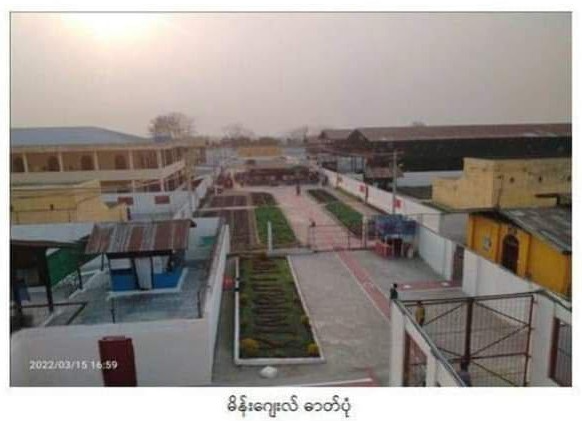Since its coup in February 2021, Myanmar’s military has massacred hundreds of innocent civilians. One such mass killing happened in Kalay jail in Sagaing Region on March 15 of last year, when prison guards shot dead inmates in cold blood. Among the inmates in the jail at the time of the massacre was Kyaw Kyaw Moe, a senior functionary of the National League for Democracy (NLD). Kyaw Kyaw Moe had participated in the anti-coup protests at Kalay. He was arrested and imprisoned for 23 months for not wearing a mask during the COVID-19 pandemic.
According to media reports of the killings in Kalay jail, seven inmates were killed, and 30 others were injured. Junta authorities cited in the report claimed that inmates had taken three prison guards hostage during an attempted jailbreak. Kyaw Kyaw Moe spoke to The Diplomat at Kalay on January 24 of this year. Here is his account of what happened at Kalay jail on the evening of March 15, 2022:
I was lodged in a single cell in Kalay jail. I was not tortured like the other inmates. An overwhelming majority of the 400 prisoners were arrested after the coup on fabricated charges. They had gone through brutal tortures in the room adjacent to the jail. The reason was that the authorities wanted to extract information from them about the movement against the junta. They were beaten with wires and rods and sometimes subjected to electric shocks. The extent and nature of the torture would vary, and the worst torture was reserved for government employees, who had participated in the civil disobedience movement (CDM). The torture would last for several hours and after it ended some convicts needed to be carried back to their cells by the guards.

A view of Kalay Jail in Myanmar. Credit: Special Arrangement
Tension was gradually building up in the jail. It was overcrowded and the infrastructure was inadequate to support the 1,180 inmates. The medical facilities were meager. Medicines were not available on time. Nor would doctors come to attend to the sick. I was quite fortunate not to have fallen sick during my incarceration of almost 23 months. So, there were frequent protests and heated arguments between the guards and inmates.
I can recall at least four such instances before the killings took place when the situation could have worsened. On two occasions, the guards at the watch towers pointed their rifles at the rowdy inmates and warned that they would pull the trigger if they did not return to their cells. And they did go back to their cells.
The killings happened on March 15 last year. It all started at about 4:30 p.m. For some reason, there was a quarrel between a group of about three dozen convicts and three prison staff at the center of the jail. This was nothing unusual and I kept on watching everything from my cell, which was on the ground floor. But the arguments between the two sides escalated within a couple of minutes. The convicts surrounded the staff, shoved them and they were barred from returning to their office.
At this point, I noticed the guards in the two watch towers on either side of the gate picking up their G-3 rifles and pointing them at the quarreling group. It appeared to me that they were not able to decide on the next course of action. They watched for another minute or so when more guards began climbing the tower. I think there were a total of seven guards in the two towers; all of them were armed with the same kind of rifles. Since there was no sign of the scuffle coming to an end, they decided to pull the trigger. One guard on the right tower screamed and gave directions. I think it was sort of an order to take proper aim and shoot the inmates without injuring the prison staff.
And so, it started. The guards took aim at each of the convicts who were engaged in assaulting the prison staff. The firing lasted for about 15 minutes. Nine people died on the spot and more than 20 were injured. Most of them died instantly with blood oozing out from their heads. The injured lay on the ground with the dead bodies for about half an hour before they were dragged by the guards and taken to the hospital. We heard that many more died in hospital, but we do not know the actual number. Many among the injured were never seen again. Some of those who recovered were back in jail again.
Security was beefed up in the jail after this incident. All inmates were put under full lockup and not allowed to move out of their cells.

































